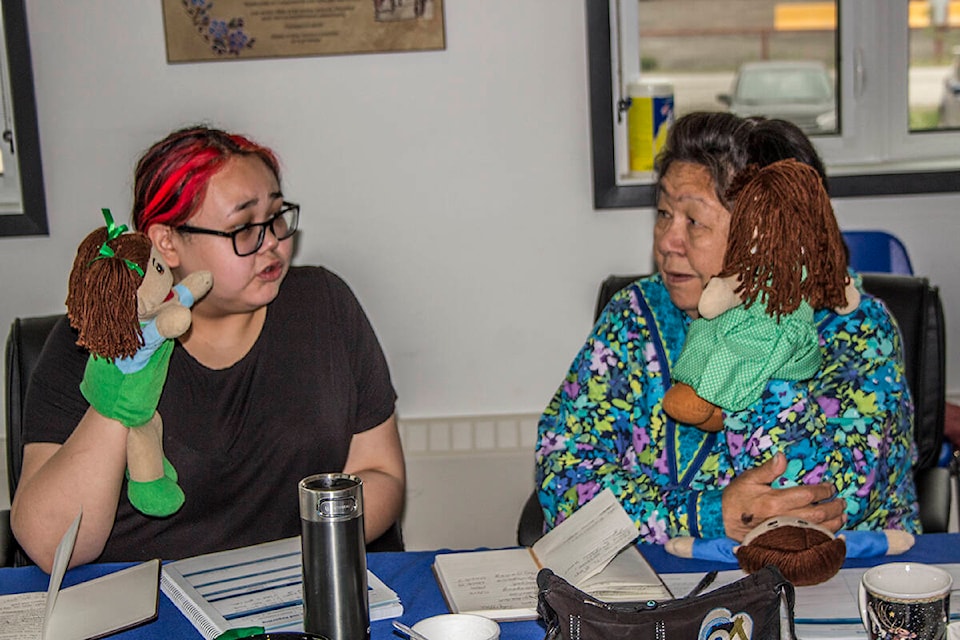Among the many learning-pairs taking part in this year’s Mentor Apprentice Program, there is one clear common opinion.
Everyone loves the puppets.
“It’s just more engaging. You get to not only talk about yourself, but you can talk about others such as your family members and whatnot,” said Delanie Elias, who is learning Inuvialuktun with her grandmother Shirley. “Right now we’re working on the basic introduction. Introducing my name, my age, where I’m from…
“As you introduce yourself to Elders, they usually tend to ask who your parents are, who your grandparents are, because, you know, they usually know you by them. So I’m working on introducing my grandparents as well.”
Puppets are one of several activities being used to assist in the program, which pairs an student with a fluent speaker of one of the many Indigenous languages of the Northwest Territories. The costs of the program are split between the territorial government and the Indigenous government of the language being taught, with each covering the costs of 100 hours of instruction.
Other tools include flash cards, stories and just talking. This is the third year the Mentor-Apprentice, which kicked off July 12 and will run until March 21, 2022, cumulating in a final gathering of celebration where participants will demonstrate what they have learned.
“I’m really excited another family member is learning to speak our language. Before that, it has always just been me and Albert (her husband,)” said Shirley Elias. “So it makes me feel really happy now that she is wanting to learn the language more in depth. Learning the words and the phrases is a big step for her.”
Shirley and Delanie are one of 47 pairs in the program this year, a nearly 50 per cent increase from the 33 pairs who entered the program last year. Many participants and 16 pairs are returning from last year. After completing a two-day orienteering session July 13 and 14, each pair will interact, both in person and online, over the next nine month, in an immersive learning environment allowing Elders and other skilled speakers of their mother tongues to pass on their knowledge. The program also has a book club which connects online every two weeks, as well as monthly webinars for further education, driven by the interests of the participants.
There will also be three wellness check ins over the course of the program, as learning a language can open up a number of emotions a student may not be prepared for.
To help cover the extensive time it takes to practice language and do lessons, participants are also compensated, to the tune of $30 per hour for a mentor and $25 per hour for students. The time commitment to complete the program is about seven to 10 hours per week.
Many of the pairs are family-connections, helping to pass their language between generations.
“My mom did the math program with somebody else last year,” said Margaret Mitchell, who is learning Dinjii zhuh ginjik with her mother, Agnes Mitchell. “She suggested that we do it so I can progress in my language.
“I already did this through on the GTC and all that so I know a little bit. I’m just learning more. I want to speak fluent Dinjii zhuh with my mom.”
Mitchell said Dinjii zhuh ginjik is often thought of a dialect of Gwich’in, but Agnes, who hails from Tsiigehtchic, said Dinjii zhuh ginjik is a language in of itself.
She said Gwich’in was traditionally used as an ending to places on the land to identify where families traditionally lived, but the people in the Tsiigehtchic area used to refer to themselves as Dinjii zhuh, or ‘native to a place.’ The blanket use of Gwich’in is a more recent development used by government. The pair travelled up from Edmonton to their homeland to participate in the program.
“The reason I asked my daughter to be my apprentice is we live in Edmonton,” said Agnes Mitchell. “We frequently get together, so I thought that would be better than trying to connect with somebody from another community. Like trying to get phone calls and scheduled zoom sessions or something. It’s pretty hard to do that. So I’m happy for this and I look forward to the year.”
